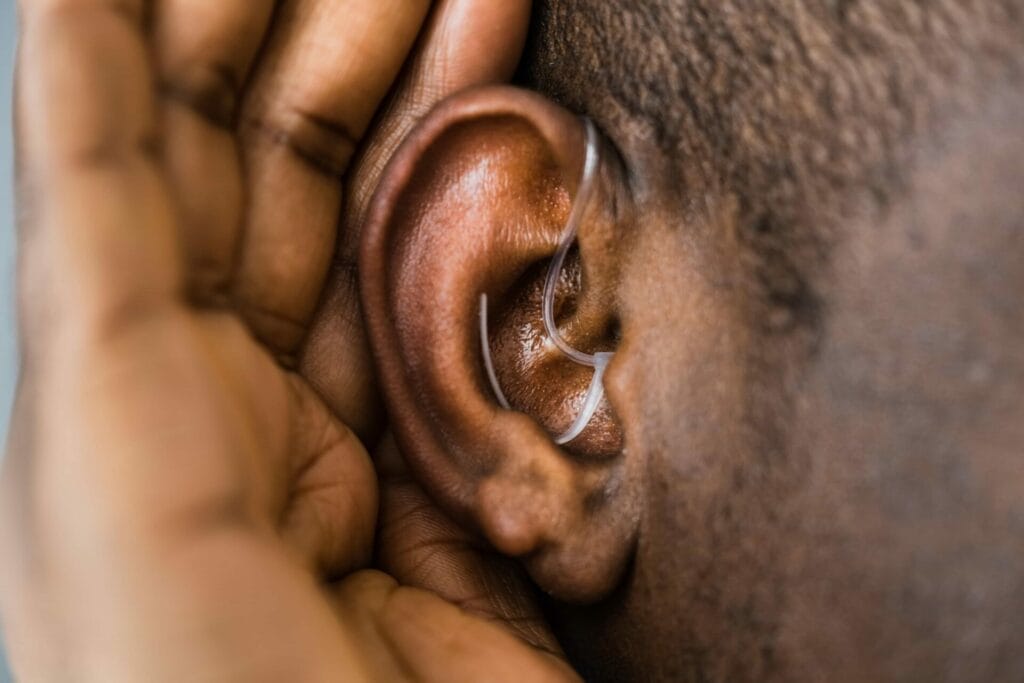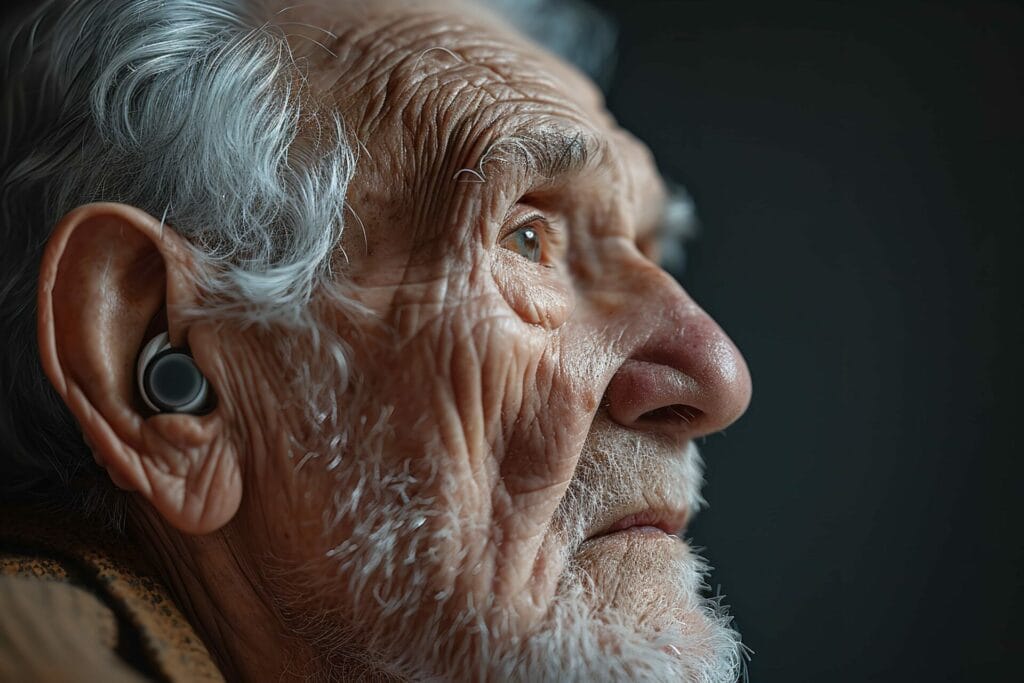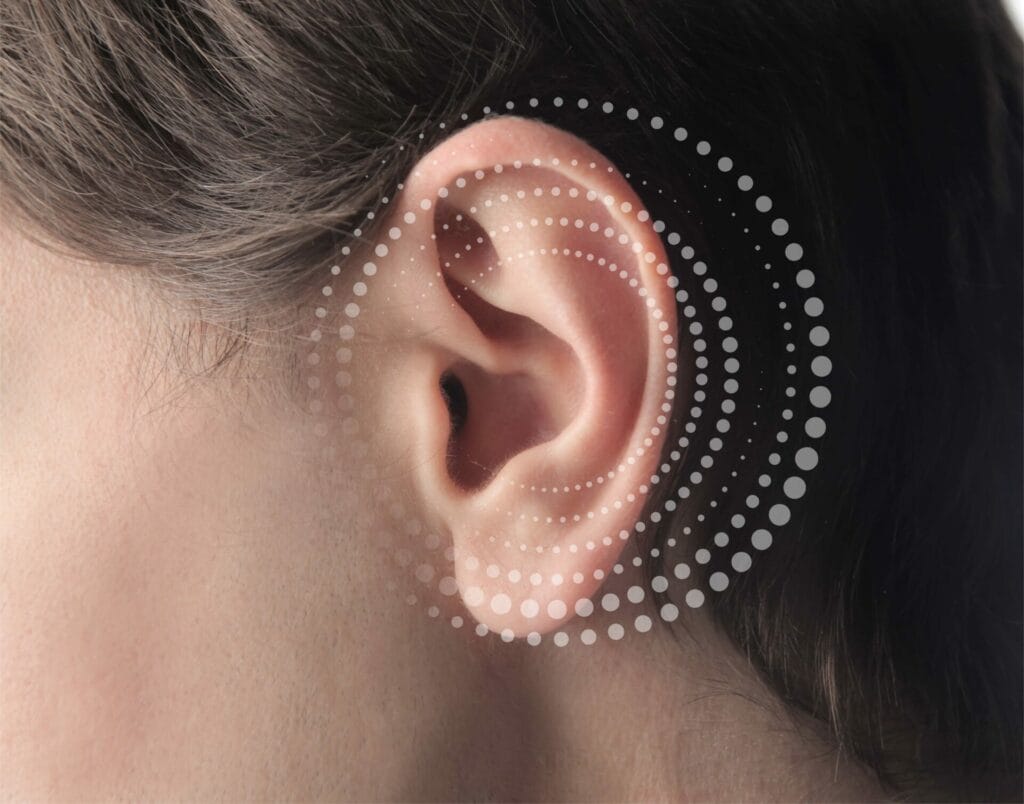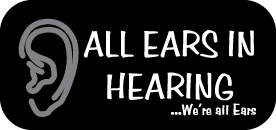Table of Contents
The role of an audiologist in hearing aid fitting

The World Health Organization (WHO) estimates that over 5% of the world’s population – approximately 466 million people – suffer from disabling hearing loss. This number is expected to rise to over 900 million by 2050. Such statistics highlight not just the prevalence of hearing loss but also the increasing demand for solutions to address it. Enter the realm of hearing aids: technological marvels designed to amplify sound and make it clearer, thus helping individuals reconnect with their surroundings.
However, the journey to better hearing isn’t as simple as just picking a hearing aid off a shelf. The intricate process of hearing aid selection and fitting requires expertise, precision, and an understanding of an individual’s unique hearing profile. This is where audiology plays a pivotal role. Through comprehensive assessments and personalsed recommendations, audiologists work to ensure that individuals receive the optimal hearing solution tailored to their needs.

The Hearing Assessment Process
Audiological evaluations are a cornerstone in diagnosing and managing hearing loss. The diagnosis process is multifaceted, ensuring a comprehensive understanding of an individual’s auditory health and needs.
Definition of a Comprehensive Audiological Evaluation
A comprehensive audiological evaluation is a series of various hearing tests, conducted by a licensed audiologist to determine the nature, type, and severity of hearing loss. It serves as a baseline for any future assessments and is crucial in determining the appropriate course of intervention.
Components of the Assessment
- Pure-tone Audiometry: This is the most common hearing test. It measures the softest sound a person can hear at different frequencies. Patients respond when they hear a tone through headphones. The results are plotted on an audiogram, a graph that shows hearing sensitivity across various pitches.
- Speech Audiometry: This test assesses the individual’s ability to hear and understand speech. It involves two main measures:
- Speech Recognition Threshold (SRT): The faintest level at which a person can recognize words or speech stimuli half of the time.
- Word Recognition Score (WRS): This measures how well a person understands words at a comfortably loud volume.
- Tympanometry: It’s a test that examines the middle ear’s function by assessing the movement of the eardrum in response to air pressure changes. It helps in identifying issues like ear infections, fluid build-up, or eardrum perforation.
- Otoacoustic Emissions (OAEs): OAEs are faint sounds that the inner ear produces. If these sounds are absent, it often indicates a hearing loss. This test is frequently used for newborn hearing screenings.
Interpreting the Results
- Understanding the Type of Hearing Loss:
- Conductive Hearing Loss: Issues with the outer or middle ear, often caused by infections, blockages, or anatomical anomalies.
- Sensorineural Hearing Loss: Issues with the inner ear or auditory nerve, often due to aging, noise exposure, or genetic factors.
- Mixed Hearing Loss: A combination of both conductive and sensorineural issues.
- Degree of Hearing Loss: This is categorised based on how loud sounds need to be for a person to hear them. Categories include:
- Mild
- Moderate
- Moderately-severe
- Severe
- Profound
- Configuration of Hearing Loss: Describes how hearing loss varies across pitches or frequencies. For example, some may have a sloping loss, where hearing is better at low frequencies and worse at high frequencies.
Candidacy for Hearing Aids
Hearing loss affects millions of people worldwide, from the very young to the elderly. However, not every individual with hearing loss is automatically a candidate for hearing aids. Determining the need for hearing aids involves a combination of audiological evaluations, patient history, and individual needs. Let’s delve into the factors that help determine this candidacy.

Degree of Hearing Loss
- Mild Hearing Loss: People with mild hearing loss might find it challenging to hear soft sounds or understand speech in noisy environments. While some might benefit from hearing aids, others might not feel the need just yet.
- Moderate Hearing Loss: Those with moderate hearing loss often have difficulty understanding speech, especially if there’s background noise. Most individuals in this category benefit significantly from hearing aids.
- Severe and Profound Hearing Loss: Individuals in this category can’t hear most conversations and loud sounds. Hearing aids are usually essential, though some might require cochlear implants or other assistive listening devices.
Lifestyle Needs
Hearing needs can vary based on one’s lifestyle. A retired individual spending most of their time at home might have different auditory needs than a business professional frequently on phone calls or attending meetings. By understanding a patient’s daily activities, audiologists can better determine the necessity and type of hearing aid.
Manual Dexterity
Hearing aids come in various styles and sises. For individuals with challenges in manual dexterity, such as arthritis or other motor issues, certain styles might be more appropriate than others. Audiologists consider this when recommending a particular type of hearing aid.

Importance of a Thorough Case History
Taking a detailed case history is crucial. This includes understanding:
- The onset of hearing loss (sudden or gradual).
- Any related medical conditions.
- The patient’s perception of their hearing challenges.
- Feedback from family or friends about the patient’s hearing.
A comprehensive case history provides a holistic view, helping the audiologist make an informed recommendation to other health professionals about hearing aid candidacy.
Additional Considerations
- Tinnitus: Some individuals experience ringing, buzzing, or other sounds in their ears, known as tinnitus. While hearing aids can’t cure tinnitus, they can sometimes help manage it.
- Listening Environments: Regular attendance at concerts, theaters, or religious services can influence the type of hearing aid recommended.
- Budget: While audiologists strive to recommend the best solution for the patient, they also need to consider the patient’s budget.
Determining candidacy for hearing aids is a multifaceted process, combining clinical expertise with an understanding of the patient’s individual needs and lifestyle. While the degree of hearing loss is a significant factor, the final decision often rests on a combination of factors, underscoring the importance of personalised care in all audiology services.
The Role of Audiologists in Hearing Aid Selection
Importance of Individualised Hearing Aid Recommendations
Every individual’s hearing loss and auditory needs are unique. Audiologists play a critical role in the hearing services program ensuring that hearing aid recommendations are tailored to meet these individual requirements. They use the results of the audiological evaluation, combined with a patient’s lifestyle needs and preferences, to make the most suitable recommendation.
Factors Influencing Hearing Aid Selection
- Patient’s Auditory Needs: The nature and degree of the hearing loss, as well as the patient’s communication needs, play a significant role in the selection process. For example, someone who attends frequent meetings or enjoys theater might need different features than someone who leads a quieter lifestyle.
- Cosmetic Preferences: Some individuals might prioritise discretion and prefer hearing aids that are less visible, such as in-the-canal styles. Others might not have a cosmetic preference and instead prioritise ease of handling or other features.
- Budget Considerations: Hearing aids come in a range of prices depending on their features and brand. An audiologist will always ensure that the most suitable options are presented within the patient’s budget.
- Technological Features Desired: Modern hearing aids come with various features such as directional microphones, wireless connectivity, tinnitus maskers, and rechargeability. The audiologist will discuss these options and help the patient determine which are most beneficial for their needs.
Different Styles of Hearing Aids
Different styles of hearing aids serve different purposes and have their own sets of advantages and disadvantages. Here’s a brief overview:
- Behind-the-Ear (BTE): These hearing aids sit behind the ear and are connected to an earmold or ear tip that fits inside the outer ear. They are suitable for almost all types of hearing loss and are often chosen for their durability and ease of handling.
- In-the-Ear (ITE): These are custom-made to fit the outer entrance of the ear. They’re generally not as visible as BTE styles and can be used for mild to severe hearing loss.
- Completely-in-the-Canal (CIC): These are custom-made to fit entirely inside the ear canal, making them nearly invisible. They’re suitable for mild to moderately-severe hearing loss.
- In-the-Canal (ITC): These are slightly larger than CIC hearing aids and are partially visible in the outer ear. They can accommodate a wider range of hearing loss than CIC devices.
- Receiver-in-Canal (RIC) or Receiver-in-the-Ear (RITE): These are similar to BTE hearing aids but are typically smaller because the speaker is located in the ear tip, not the main body of the hearing aid.

The Fitting Process
The hearing aid fitting process is a crucial phase in an individual’s journey to better hearing with hearing aids. It’s not just about placing the device in the ear, but ensuring that the hearing aid is tailored to the individual’s specific hearing loss, lifestyle, and preferences.
Importance of a Precise Fit
- A precise fit ensures optimal hearing aid performance. An ill-fitting hearing aid can cause discomfort, feedback (whistling sound), and may not provide the desired amplification.
- The ear canal’s anatomy varies from person to person, making it essential to have a device that fits comfortably and securely.
Real-Ear Measurements (REM)
- REM is a method used by audiologists to verify that the hearing aid’s output matches the prescribed amplification for the wearer.
- During this procedure, a small microphone is placed inside the ear canal alongside the hearing aid. As sounds are played, the microphone measures the exact sound levels the wearer is receiving from the hearing aid.
- This ensures that the hearing aid is delivering the right amount of amplification across different frequencies.
Verification vs. Validation in the Fitting Process
- Verification: This is an objective measure where the audiologist ensures that the hearing aid is providing the correct amount of amplification based on the wearer’s hearing loss. Tools like REM are used for verification.
- Validation: This is a subjective measure where the wearer provides feedback on how the hearing aid sounds in different environments. For example, they might wear the hearing aid in quiet settings, noisy environments, or while listening to music. The goal is to ensure the wearer is satisfied with the sound quality and clarity.
Fine-tuning and Adjustments
- After the initial fitting, wearers often return for adjustments based on their real-world experiences. This might include changes in volume, frequency response, or features like noise reduction.
- Modern hearing aids are equipped with digital technology, allowing audiologists to make precise adjustments to fit the wearer’s needs.
Importance of Feedback Management
- Feedback, or the whistling sound often associated with hearing aids, can occur if the device is not fitting properly or if there’s an issue with the settings.
- Audiologists use various techniques and technologies to manage and reduce feedback, ensuring a comfortable and clear listening experience.
Post-fitting Follow-ups and Adjustments
After the initial fitting of hearing aids, the journey towards optimal hearing doesn’t end. This period, often referred to by health professionals as the acclimatisation phase, is crucial as the wearer gets used to the new sounds and sensations. During this time, regular follow-ups with the audiologist are paramount to ensure the hearing aids are performing optimally and addressing the user’s unique needs.
The Acclimatisation Period
- Understanding Acclimatisation: For many new hearing aid users, it’s been years since they’ve heard certain sounds. Whether it’s the rustling of leaves, the hum of a refrigerator, or even their own voice, these sounds can initially feel overwhelming or distracting.
- Duration: The acclimatisation period can vary from one individual to another, typically ranging from a few weeks to several months.
- Importance: During this time, the brain relearns how to prioritise and process auditory stimuli, gradually leading to a more natural hearing experience.
Importance of Regular Follow-ups
- Monitoring Performance: Regular check-ins allow the audiologist to ensure that the hearing aids are functioning as they should. This includes checking the physical fit, battery life, and sound quality.
- Addressing Discomfort: Any physical discomfort, like tenderness or soreness in the ear, should be addressed immediately. Adjustments to the hearing aid mold or shell can alleviate these issues.
- Sound Adjustments: Based on the user’s feedback, the audiologist might make changes to the hearing aid’s programming to ensure sounds are clear and comfortable.
Tackling Common Issues
- Feedback Issues: A common problem with hearing aids is the whistling sound known as feedback. This can be caused by a variety of factors such as a poor fit, earwax, or even a damaged hearing aid. Audiologists can identify the cause and rectify it.
- Occlusion Effect: Some users might feel that their voice sounds ‘boomy’ or like they are ‘talking in a barrel’. This is known as the occlusion effect and can often be minimised with adjustments to the hearing aid or its fit.
- Connectivity Problems: Modern hearing aids often come with wireless connectivity options, allowing users to connect them to smartphones, TVs, and other devices. Connectivity issues, if they arise, can be troubleshooted during follow-ups.
The Role of the User
- Keeping a Diary: It’s beneficial for users to keep a diary of their hearing aid experiences. Noting down situations where they struggled to hear or felt discomfort can provide invaluable feedback to the audiologist.
- Maintenance: Users should be proactive in cleaning their hearing aids and changing batteries or charging them as needed. Regular maintenance ensures longevity and optimal performance.
Post-fitting care is just as vital as the initial selection and fitting of hearing aids. With a combination of professional guidance from the audiologist and proactive participation from the user, hearing aids can truly transform lives by reconnecting individuals with the world of sound.

Counselling and Education
The Importance of Counselling in Audiology Audiological counseling is more than just a discussion about hearing loss and the mechanics of hearing aids. It’s an essential component in ensuring that patients are mentally and emotionally prepared for the changes and challenges associated with using hearing aids. Through counseling, audiologists can address patients’ fears, misconceptions, and expectations about hearing aids, ensuring a smoother transition to better hearing.
Setting Realistic Expectations One of the first steps in audiological counseling is to set realistic expectations. While hearing aids are designed to improve auditory experiences, they don’t restore natural hearing. It’s crucial for patients to understand the capabilities and limitations of their devices. This understanding can prevent potential disappointments and frustrations down the line.
Addressing Common Concerns Many first-time hearing aid users have a plethora of concerns, ranging from device visibility and comfort to fears about device malfunction or social stigmas. Audiologists play a crucial role in:
- Explaining the discreteness of modern hearing aids.
- Providing comfort tips and solutions.
- Dispelling myths about hearing aids.
- Offering strategies to handle social situations with confidence.
Education on Hearing Aid Use and Maintenance Audiologists ensure that patients know how to:
- Properly insert and remove their hearing aids.
- Change batteries or charge their devices.
- Clean and maintain their hearing aids to prolong device lifespan.
- Troubleshoot minor issues.
Moreover, audiologists introduce patients to different listening environments, helping them adjust to various auditory scenarios, from quiet conversations to noisy public spaces.
Communication Strategies Beyond device mechanics, audiologists offer valuable strategies to optimise communication:
Advocating for favourable seating in group settings, such as sitting with one’s back to the noise.
Using visual cues and lip reading to supplement auditory information.
Encouraging open communication with friends and family about hearing needs.
Emotional Support and Resources The journey to better hearing can be emotional. Recognising this, audiologists often provide:
- Emotional support, understanding, and patience.
- Resources such as support groups or therapy for those struggling with the psychological impact of hearing loss.
The Role of Family in the Process Audiologists often encourage the involvement of their children, family members or close friends in the counseling process. Their participation can:
- Provide additional support to the patient.
- Educate loved ones about hearing loss, fostering empathy.
- Equip family members with communication strategies to ensure effective interactions.

The Future of Audiology and Hearing Aid Technology
Technological Advancements in Hearing Aids
- Machine Learning and AI: Modern hearing aids are increasingly incorporating machine learning algorithms to better adapt to a user’s environment. This allows the device to “learn” the user’s preferences in various situations and adjust settings accordingly.
- Extended Battery Life and Rechargeability: As battery technology continues to advance, we can expect hearing aids with longer battery life and quicker charging times. Some of the latest models even offer wireless charging capabilities.
- Direct Connectivity: With the rise of Bluetooth and wireless technology, newer hearing aids can directly connect to smartphones, televisions, and other devices, making the listening experience more seamless and integrated.
Personalised Hearing Solutions
- Hearing Aid Customisation: As technology advances, there’s a growing potential for hearing aids to be even more tailored to an individual’s hearing profile, lifestyle, and aesthetic preferences.
- Genetic Approaches: In the future, research into the genetic causes of hearing loss might pave the way for treatments that are tailored based on an individual’s genetic makeup.
Tele-Audiology and Remote Services
- Remote Fitting: With the integration of internet connectivity, audiologists might be able to adjust a patient’s hearing aid settings remotely, eliminating the need for frequent in-office visits.
- Virtual Consultations: Tele-audiology can facilitate consultations, follow-ups, and counseling sessions via video calls, making audiological care more accessible, especially for those in remote areas.
Integration with Health Monitoring Systems
Many tech companies are looking into integrating health monitoring systems within hearing aids. This could mean that future hearing aids might monitor vital signs, track physical activity, or even detect falls.
Over-the-Counter Hearing Aids
In some regions, there’s a move towards allowing certain types of hearing aids to be sold over the counter. This can make hearing aids more accessible and affordable but also highlights the importance of professional audiological guidance for optimal results.
The Evolving Role of Audiologists
- As technology progresses, the role of audiologists will likely shift from not just fitting and adjusting hearing aids but also to being educators and consultants in the realm of hearing technology.
- The demand for their expertise in counseling, troubleshooting, and personalised care will remain indispensable, ensuring that individuals get the most out of the advanced features of modern hearing aids.
Conclusion
The Indispensable Role of Audiologists: Audiologists are the cornerstone of effective hearing aid provision. From the initial assessment to the fitting and ongoing adjustments, their expertise ensures that individuals with hearing loss receive devices that truly enhance their auditory experience. While technology continues to evolve, the human touch and professional judgment of an audiologist cannot be replicated by machines.
The Value of Professional Guidance
With the myriad of hearing aid options available in the market, it can be overwhelming for individuals to make a decision. Audiologists play a crucial role in navigating these choices, ensuring that the selected hearing care device meets the specific auditory needs, lifestyle preferences, and budget constraints of the patient. Their guidance is invaluable in ensuring that individuals make an informed decision and get the most out of their hearing aids.
Emphasising Regular Check-ups
As with any medical device, hearing aids require regular maintenance and adjustments to function optimally. It’s essential for individuals to understand the significance of routine check-ups with their audiologist. This not only ensures the longevity of the hearing device but also guarantees that any changes in hearing or device performance are promptly addressed.
The Importance of Education and Counseling
While technology can aid in hearing, the emotional and psychological aspects of hearing loss are equally crucial. Audiologists provide the necessary counseling to help individuals cope with the challenges of hearing, loss and balance disorders, teaching them strategies to communicate more effectively and ensuring they have realistic expectations from their devices.
As we look to the future, the role of audiologists and professionals will continue to be of paramount importance. They bridge the gap between technological advancements and the real-world needs of those with hearing impairments. Their dedication to the field ensures that individuals with hearing loss can enjoy a better quality of life.
DISCLAIMER:
The information on this website is provided for educational purposes only. We do not support, nor recommend any products or treatments without proper hearing diagnostic and proper hearing evaluation. All users must seek professional advice before beginning treatment as well as inform themselves of known side effects/risks associated with said procedure(s).
Check more related topics below.
Of our 5 senses, hearing is probably the most important for our feeling of connection to the world around us. It allows us to communicate with friends and family, enjoy the sounds around us like music or nature and helps keep us safe by alerting us to warning signals, the various sounds in traffic and other forms of danger. To properly understand how we conduct a hearing test, it is best to understand how the ear works.
